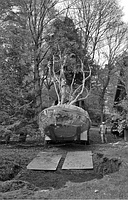A Tree Moves to Palisades
If you read a landscape as a story (romantic, naturally) then trees are our heroes, our character actors and, from time to time, the lurking villain. Architecture introduced into the landscape can insert itself effortlessly into the plot line. The story is transformed into a play; the landscape becomes theatrical set. But what happens when there is disaster on the set and the hero dies? The play becomes a tragedy.
This is what happened when, after a new swimming pool was installed, the stately tree that stood to the front right of the porch of Andrew Goffe and Jeff Levin’s guesthouse died in the fall. That tree had held the stage, anchoring house to landscape, separating yet introducing the house to its surrounds.
We had a murder mystery on our hands. Suspicion was laid on the roughhousing tactics of the digging machinery during construction. They were surely responsible for the death through over-compaction of the soil, though the accused protested their innocence. Whatever the cause, a new hero needed to be found to replace the dead tree.
The talent search was on. A young starlet would not be able to carry the role; we needed an actor of a similar stature to the mature tree that was lost. The surrounding landscape of Norway maples, sugar maples, black locusts and chest- nut trees are all green. We needed a Japanese maple, Acer palmatum ‘Bloodgood,’ a lady in red. Bloodgood maples are not uncommon, but the size we required was.
Having visited the more well known tree nurseries over the years, I wasn’t sure where we would find the talent. But in this business it helps to know people who know people. Pete Proulx, the contractor responsible for the work on site, mentioned a place I might be interested in visiting.
Enter tree impresario Mike Yeager and the most remarkably well-kept tree nursery that I’ve visited in the US. Mike is an expert arborist and nurseryman who has been in business for the past 35 years, using traditional techniques that few industry people use anymore. The difference is obvious the moment you walk around his property, a private arboretum around his own home that he operates with his brother Kenny alongside the open-to-the-public Hickory Hollow Nursery. All the specimen trees are for sale, each chosen and trained with a connoisseur’s eye.
When we spotted the Japanese maple, there was immediate chemistry. Standing at 30 feet tall, our star had been found. Her beauty and charisma was undeniable. Mike and Kenny had purchased her from a grafting operation. Grafting is the process of making cuttings from a tree to make clones of the original. Eventually she had grown so large that to climb her to take cuttings had become too laborious, so twenty years ago she was sold to Mike and Kenny.
Mike tells me that they like to buy trees from grafting nurseries because the process of constant pruning for grafting cuttings results in trees of extraordinary character. Mike has been further expertly pruning this maple for the past twenty years, resulting in a beauty of exceptional grace. Mike and Kenny keep their trees on a rigorous schedule of root pruning every 2 to 4 years. Root pruning means cutting around the root ball to encourage the growth of a mass of fibrous roots. Thus, when a tree is moved, it has a healthy life support system to ensure the immediate uptake of water and nutrients. Other tree nurseries don’t follow such a program so the survival rate is lower.
The job of moving and planting the tree was still a major challenge. The root ball itself was nine feet and four inches wide, and weighed six and half tons, not including the tree itself! One mistaken move could tear off one of the sinuous curving limbs, ruining the tree’s shape for good. Pete Proulx was charged with this unenviable responsibility and planned it like a military general. Multiple trucks, cranes, forklifts and a large team of men with various skills were brought in, along with a drone to film the process for posterity.
And then there was a twist in the plot. It was the day before the big move. The hole had been dug and carefully prepared with gravel and compost. But the next morning when Pete arrived on site, it was filled with water. Pete dug and laid drains to allow the water to subside, then Mike Yeager investigated the hole. He found remnants of the root ball of the previous inhabitant, which were blue. In a last minute reveal, we had been given the clue to the death of the previous tree, and essential information to ensure the survival of our new arrival.
Rather than soil compression from the construction being the culprit, blue roots were proof of death by drowning. Excess water had collected around the previous tree’s roots, restricting oxygen uptake. Why, after at least 30 years of healthy growth had this happened? Apparently the existing water table had changed by the imposition of the pool, and the passage of water run-off changed as well.
Equanimity has been restored to this plot off Lawrence Lane. The murder mystery has been solved and a stunning new actor is now enjoying the spotlight, ready for her admiring audience when she unfurls for her true debut next spring.


